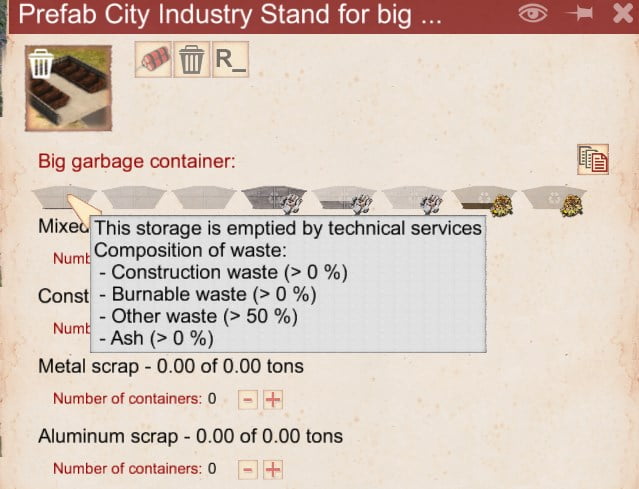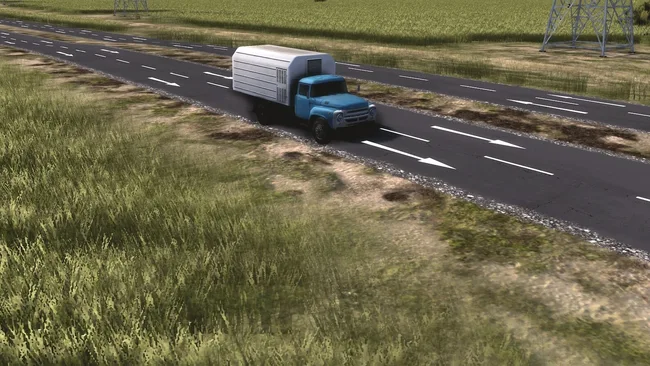Table of Contents Show
Workers & Resources: Soviet Republic Waste Management Guide
Workers and Resources is a complicated game, when you are new (or newish) it is very easy to struggle with basic things like getting public transport working.
Glossary
The developers have got some terrible names for their new buildings so I’m going to provide my own words for their buildings
- * Transfer for big garbage containers (small) => Small Garbage Transfer Station
- * Transfer for big garbage containers (large) => Large Garbage Transfer Station
- * Small garbage stand (small) => Small Residential Garbage Stand
- * Small garbage stand (large) => Large Residential Garbage Stand
- * Big garbage stand (small) => Small Industrial Garbage Stand
- * Big garbage stand (large) => Large Industrial Garbage Stand
Residential garbage stands vs industrial garbage stands
Small garbage trucks can only pick up from residential garbage stands, residential buildings and service buildings. Big garbage trucks can only pick up from industry garbage stands and industrial buildings.
Consider using industry (big) garbage stands in residential areas
The large residential garbage and the small industrial garbage stands are similar in size but the industry one holds 50t more of waste.
You can reduce traffic by using the big garbage trucks and industry garbage stands, since garbage trucks will be able to pick up 6.5t of waste at a time. The only downside is that you can’t build them on pedestrian paths.
Checking the contents of mixed waste
You can tell what the mixed waste consists of by mousing over it and looking at the tooltip.

Waste sorting in Garbage Stands
Residential waste sorting
- For hospitals and clinics you need to configure a few containers nearby to hold the hazardous waste, it has internal storage for hazardous so this works without the “waste separation edification” research
- Once “waste separation edification” has been researched, then you should set containers for biological waste (assuming you want to use it), metal scrap, aluminium scrap and plastic.
Industrial waste sorting
- The “waste separation” research is not required for industrial waste sorting (except for biological waste), you can configure sorting from the very beginning. Mines creates construction waste, fabric factories creates hazardous waste, etc.
Early game setup
Use a technical office to transfer all mixed waste into a garbage transfer station, and all hazardous waste into a dump.
Keep the garbage transfer station at least 200m from your residential city.
Keep the hazardous waste dump at least 500m away from your residential city. Probably just put it in your industrial area (so 1km away).
You’ll be accumulating a lot of mixed waste and it is cheap to export (via a line or distribution office). On the other hand, you don’t produce as much hazardous waste and it is expensive to export so you can leave it in dumps to decay to much longer. Later on you can just burn it or treat it.
Mid game setup
Technical office => (Truck) => Garbage Transfer Station => (Truck/Factory Connection) => General Separation Building => (Factory Connection) => Dump => (Factory Connection) => Incinerator => (Factory Connection) => Garbage Transfer Station => (Truck) Customs House
If you burn hazardous waste, you should keep the incinerator 1.5km from residential areas. Otherwise, 1km is good enough.
Late game setup
There isn’t anything special you need to do in the late game. Sorting and incineration should be done locally (within 1.5km). Then what’s left should be recycled or exported.
There are specialised buildings for sorting metal scrap and aluminium scrap at a higher efficiency than the general separation. The difference in efficiency is only 10% and most scrap should be sorted out in the garbage stands anyway, so they don’t seem worthwhile.
Coal mines, iron mines and waste
Coal and iron mines produce a lot of waste.
It is best to attach a garbage transfer station directly to coal and iron mines (via the factory connection) because technical offices will struggle to handle them. You can move the garbage from the garbage transfer station via a line or distribution offices.
You should (a) configure waste sorting for construction waste in the garbage transfer station and garbage stands, (b) send the construction waste to a local gravel recycling plant and (c) send the mixed waste to a local incinerator.
This will reduce the waste that needs to be exported by 70%-80% for mixed waste and 33% for construction waste.
When to use a dump, dump with claw and garbage transfer station
It is fast to unload but really slow to load from a dump. So you mainly use them as a one way dump of garbage (e.g. hazardous waste) or as intermediate storage (e.g. between the general separation building and the incinerator).
The biggest “dump with claw” building has a rail connection, so you use that to move waste around with trains. The smaller “dump with claw” buildings can be used when you want the waste to decay before you transfer it. For example, wanting biological waste to decay into fertiliser.
The garbage transfer station is what you use for holding garbage until you move it somewhere else. It can hold multiple garbage types in containers and the containers can be quickly picked up by trucks.
Source: Waste Management Wiki
